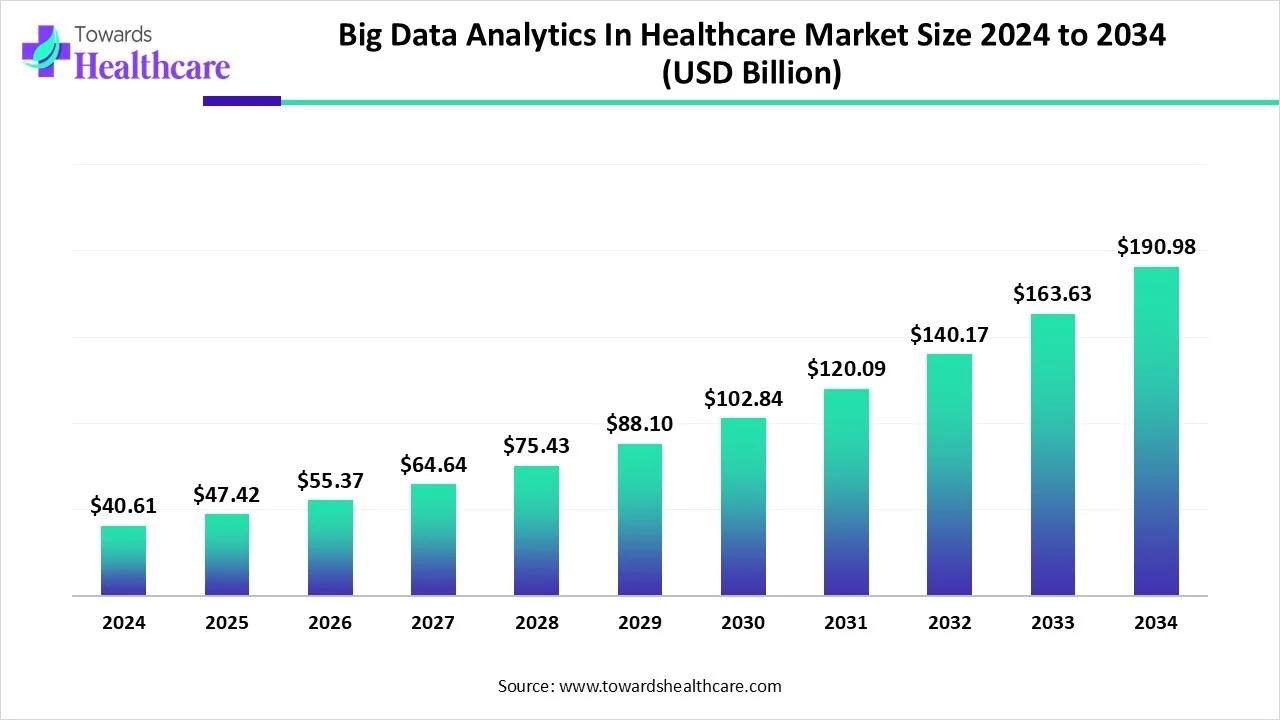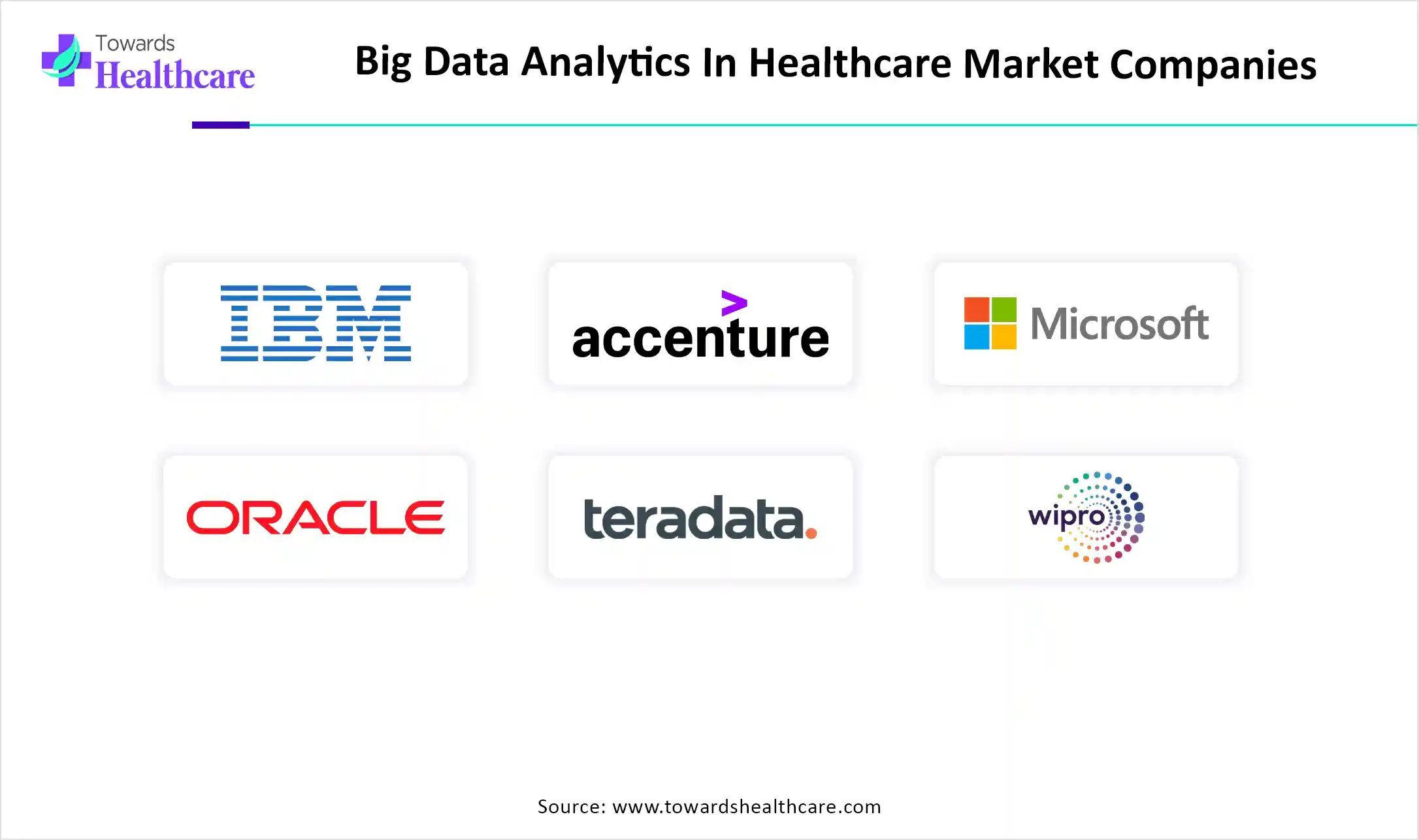December 2025

The global big data analytics in healthcare market size is calculated at USD 40.61 in 2024, grew to USD 47.42 billion in 2025, and is projected to reach around USD 190.98 billion by 2034. The market is expanding at a CAGR of 16.73% between 2025 and 2034.

| Metric | Details |
| Market Size in 2025 | USD 47.42 Billion |
| Projected Market Size in 2034 | USD 190.98 Billion |
| CAGR (2025 - 2034) | 16.73% |
| Leading Region | North America |
| Market Segmentation | By Deployment, By End User, By Application, By Component, By Region |
| Top Key Players | IBM, Accenture, Microsoft, Oracle, Teradata, Health Catalyst, Accenture, McKesson Corporation, IQVIA, Wipro |
Big data analytics in healthcare is also termed as health analytics, which includes the purpose of advanced analytical techniques to investigate large amounts of patient data to acquire insights and optimize healthcare delivery. By using different sources, like electronic health records, wearable devices, and social media, are used. Several methods are employed, such as machine learning, predictive modelling, and data mining. The growing technological advancements, including AI-powered tools, are propelling the growth of big data analytics in healthcare market. Mainly, it enhances the accuracy in diagnosis and personalized treatment plans.
AI has a major role in the market as its algorithms can investigate medical images, patient history, and other relevant data to identify diseases early, conditions like cancer, diabetes, by detecting precise patterns which may evade human detection. Although by examining an individual’s genetic patterns, lifestyle, and medical history, AI enables treatments to be more efficient and reduces the risks.
For instance,
Growing Large Amounts of Healthcare Data and EHR Acquisition
The big data analytics in healthcare market growth is generally influenced by the rising large amounts of healthcare data from different sources such as EHRs, medical imaging, wearable devices, and genomic data, contributing as an abundant source for analysis. However, government investments and demand for data-driven decision making are impelling the acquisition of EHR, which in turn generates the demand for data analytics.
Generating Breaches in Data Privacy and Security
The most important challenge is, generation of breaches in highly sensitive and confidential healthcare data, which gives rise to significant concerns. As a healthcare data breach is a major concern, organizations are prompted to prioritize security actions upon analytics. Furthermore, this can give unwillingness to acquire or boost big data analytics solutions because of the rising risk of violation of patient privacy and regulatory considerations, including HIPAA (Health Insurance Portability and Accountability Act) and GDPR (General Data Protection Regulation).
Modifications in the Healthcare System and Improved Patient Results
In the healthcare system, it is possible to detect diseases early by applying predictive analytics, and to enforce proactive medications, which minimizes the risk of chronic diseases. Further, imposing algorithms to investigate medical images and patient data, assisting in rapid and more reliable diagnoses. Also, in the case of personalized medicine, it identifies patterns and anticipates individual responses to treatment, resulting in customized and efficient therapies.
By deployment, the on-premises segment dominated the market in 2024. This segment allows healthcare organizations to achieve higher control over their data and infrastructure, which is significant in maintaining data privacy and security. Also, various healthcare organizations have robust data privacy regulations, and on-premises solutions permit a more dominated environment for compliance.
By deployment, the cloud segment is expected to grow at the fastest CAGR during the projected timeframe. In the big data analytics in healthcare market, cloud computing plays a vital role, which permits efficient data storage, analysis, and sharing. Also, it has advantages like rapid analysis, optimized access to patient data, and increased collaboration between healthcare providers. This segment is driven by the need for advanced analytics and the demand to operate large amounts of patient data.
By end user, the hospitals and clinics segment held the largest revenue in the market in 2024. Big data analytics assists in the optimization of diagnostic accuracy and in estimating and preventing risks, particularly in chronic diseases and intensive care. As well as numerous sources for data analysis, including EHRs, imaging systems, and patient monitoring devices, are needed to streamline workflows, minimize wait times, and assign resources more efficiently, which enhances the growth of the big data analytics in healthcare market.
By end user, the finance and insurance segment is expected to grow fastest during the forecast period. The finance and insurance segment is influenced by the support of big data analytics in cost improvement in different areas, like robust resource allocation, simplified workflows, and dynamic patient management. Investigating wide datasets enables the identification of patterns of false activity, which enables insurance companies to identify and prevent losses.
By application, the clinical analytics segment dominated the market in 2024. It is a major component of big data analytics in healthcare, which investigates patient information to upgrade diagnosis, treatment, and care delivery. Although it supports a high volume of healthcare data to determine patterns, anticipate results, and personalize treatment plans, it ultimately optimizes patient care and impacts efficiency in healthcare systems.
By application, the operational analytics segment is expected to grow significantly in the projected period. Predictive analytics in operational analytics supports forecasting patient admissions, estimating equipment needs, and predicting staffing demands, which is permitting for potential resource allocation and cost management. Moreover, improving care pathways and treatment protocols boosts the patient experience.
By component, the hardware segment dominated the market in 2024. The big data analytics in healthcare market comprises different components such as VPNs, firewalls, routers, data storage, and email servers & access points. Advanced firewalls are vital in protection against cyber threats and keeping patient privacy, which is widely propelling the segment growth in the market.
By component, the software segment is expected to be the fastest growing during the forecast period. The software segment assists in maintaining patients' complete medical histories, comprising diagnoses, treatments, and interventions, and electronic health records (EHRs) play a major role in the healthcare system. Including other details of patient care, from billing to collection, enables analysis to detect trends and optimize efficiency.
North America led the big data analytics in healthcare market in 2024. The factors include robust government encouragement of health IT innovations, advanced technological infrastructure, and the leading edge of novel solutions. Furthermore, there is strong ecosystem collaboration between healthcare providers, research academies, and analytical companies to tackle data for finer decision making and patient results. Also, the emerging advances in AI, machine learning, and IoT are the key drivers for the acquisition of big data analytics in healthcare, which provides highly revolutionary and more precise diagnoses and treatments.
In the US, the market is driven by factors like accelerating technological advances in healthcare IT, such as the adoption of electronic health records (EHRs) and else digital health technologies. In addition, boosting major investments in IT infrastructure by the US healthcare system, allowing the collection and investigation of large volume datasets. The patient information has been protected by employing regulations like HIPAA, which also assist in the use of information for research and development.
The market has been significantly impacted by accelerating expenses on healthcare, which is a vital factor for the market growth. Also, the healthcare system in Canada has shifted its work from paper-based to digital health records are developing huge amounts of data, generating conveniences for using big data analytics to upgrade healthcare systems. However, the Canadian Institute for Health Information (CIHI) and Canada Health Infoway are cooperating to elevate the application of digital health data, which is fueling the growth of the market.
Asia Pacific is expected to be the fastest-growing region during the forecast period. In Asia Pacific, the market is widely impelled by factors like the expansion of the healthcare IT domain, increasing expenses on healthcare, also the adoption of technological advancements in areas like AI, machine learning, and IoT. As well as emerging predictive and prescriptive analytics are improving the treatment trends, which ultimately boosts patient outcomes. Digitalized healthcare systems include the acquisition of an EHR system, telehealth, and other solutions are optimize operations with high accuracy in patient care.
In China, the significantly growing market is propelled by faster adoption of digital technologies in healthcare, such as EHRs, wearables, and telemedicine, creating ample data that fuels demand for analytics. Although, Government of China has encouraged initiatives like "Healthy China 2030," which categorizes data-driven developments in healthcare. An increasing number of chronic disease incidences requires the use of data analytics to upgrade patient care and management.
Primarily, the rising geriatric population demands specialized medical care and prophylactic healthcare, which can be noted from data analytics. The purpose of integrated AI in healthcare systems is to boost, providing highly precise and productive analysis of patient data. Increasing adoption of big data analytics is effective and optimizing patient results.
Europe is expected to grow at s significant rate during the forecast period. The big data analytics in healthcare market in Europe is adopting upgraded digital health solutions such as electronic health records (EHRs), telecare, and wearables, developing large amounts of data that can be investigated to elevate patient care. In healthcare organizations, optimization of processes and resource allocation helps to minimize operational spending and increase efficiency.
For instance,
The growing aging population and chronic diseases are driving the growth of the market, along with embracing digital health solutions, and generating novel opportunities in Germany’s healthcare system is accelerating the use of big data analytics. By employing technological advances like AI, IoT in healthcare systems is supporting the shift from volume-based to value-based care, encouraging healthcare providers and payers to use analytics to optimize effectiveness and results.
In the UK, big data analytics enables analysis of huge datasets to acquire population health trends and anticipate prospective needs is a vital driver for market growth. Also, it customizes treatments and care plans to create personalized medicines. To healthcare professionals, it provides timely decisions to the rapidly changing healthcare system.
Latin America is expected to grow at a notable CAGR in the big data analytics in healthcare market in the foreseeable future. The market is rapidly expanding due to the growing demand for digital healthcare and favorable government support. The increasing investments and collaborations among key players contribute to market growth. The rising need to deliver cost-effective preventive and predictive healthcare and the burgeoning medical tourism sector propel the market.
The Mexican government is focusing on encouraging healthcare professionals to integrate digital health technologies and improve healthcare access through EMR adoption. Mexico hosted “The Access Equation: Innovation Driving Healthcare Reach at the Mexico Health Summit 2025” to assemble leaders to explore a path forward, public-private partnerships, and innovative models to expand healthcare access.
The Brazilian Ministry of Health formed the Secretariat of Information and Digital Health to coordinate digital transformation within the SUS to expand access to high-quality healthcare and promote integral and continuous healthcare. Brazil has the largest healthcare market in Latin America, spending about 9.7% of its GDP.

By Deployment
By End User
By Application
By Component
By Region
December 2025
December 2025
December 2025
December 2025